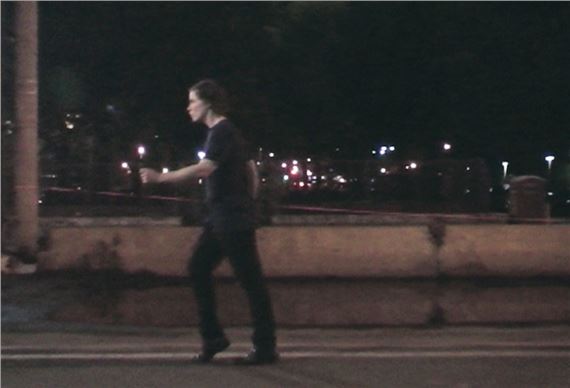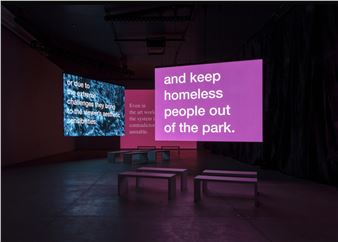On the Street
The exhibition spotlights how artists since the 1960s have explored public space, questioning and appropriating it and opening up new spaces for meaning.
Streets are more than mere places of transit. They are scenes of everyday public life, where people stroll, play, come into contact with each other, work, sell goods or protest. Often though, we only notice them in passing. On the Street invites visitors to rediscover these spaces ŌĆō as places of encounter, interaction and community, but also as scenes of protest, where people make their feelings publicly known and where social circumstances ŌĆō for example life on the street ŌĆō become visible. How does public space influence our thinking, actions and being ŌĆō and how do we actively shape it through our presence?
The history of modernism is intimately linked to the "neutral" space of art ŌĆō the "white cube". Especially since the 1960s, however, artists have been consciously breaking away from this concept. Abandoning the protected institutional setting, they take to the street ŌĆō be it as a site for radical and poetic actions or as a source of inspiration for their works. Not only redrawing the boundaries of art, this stance has also redefined the relationship between private and public space. On the Street takes a closer look at these diverse relationships ŌĆō between art, public space, museum practice and life.

Recommended for you
The exhibition spotlights how artists since the 1960s have explored public space, questioning and appropriating it and opening up new spaces for meaning.
Streets are more than mere places of transit. They are scenes of everyday public life, where people stroll, play, come into contact with each other, work, sell goods or protest. Often though, we only notice them in passing. On the Street invites visitors to rediscover these spaces ŌĆō as places of encounter, interaction and community, but also as scenes of protest, where people make their feelings publicly known and where social circumstances ŌĆō for example life on the street ŌĆō become visible. How does public space influence our thinking, actions and being ŌĆō and how do we actively shape it through our presence?
The history of modernism is intimately linked to the "neutral" space of art ŌĆō the "white cube". Especially since the 1960s, however, artists have been consciously breaking away from this concept. Abandoning the protected institutional setting, they take to the street ŌĆō be it as a site for radical and poetic actions or as a source of inspiration for their works. Not only redrawing the boundaries of art, this stance has also redefined the relationship between private and public space. On the Street takes a closer look at these diverse relationships ŌĆō between art, public space, museum practice and life.
Artists on show
- Adrian Piper
- Agnès Varda
- André Cadere
- Anita Zumbuhl
- Anna Hilti
- Anna Jermolaewa
- Corita Kent
- Damiano Curschellas
- Francis Alÿs
- Guy-Ernest Debord
- Joseph Beuys
- Lottie Child
- Lotty Rosenfeld
- Majd Abdel Hamid
- Malgorzata Mirga-Tas
- Martina Morger
- Mierle Laderman Ukeles
- Ovidiu Anton
- Rivane Neuenschwander
- Sari Dienes
- Stanley Brouwn
- Stefanie Tho╠łny
- Steina & Woody Vasulka
- Tomislav Gotovac
- William Pope.L
- Wim De Pauw
Related articles
Kunstmuseum Liechtenstein brings the vibrancy and poetry of the street into its exhibition spaces. The exhibition

 ARTISTS
ARTISTS
















